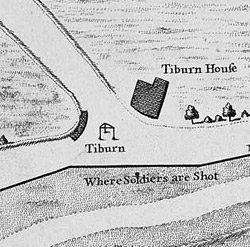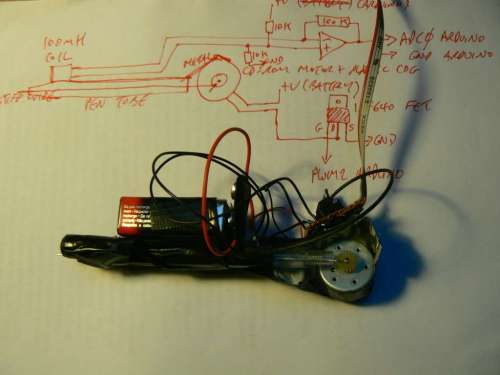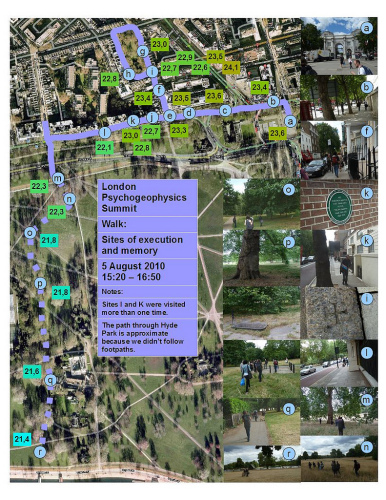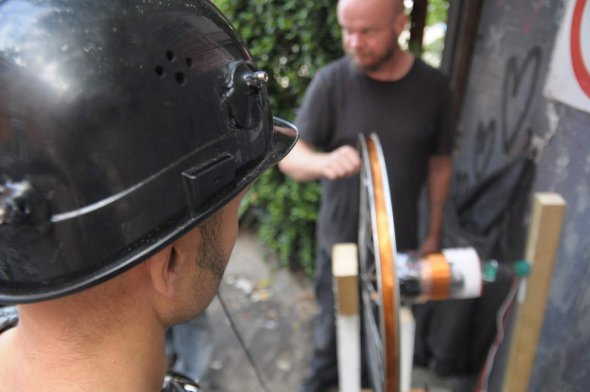Politics Here is Death
For one week the Psychogeophysical Summit merged renegade earth science, geekery and subjective mapping. Accompanied by Silje Hyenes Lysne, waving a magical video wand, remote reviewer Anthony Iles scried what he could
Video: The Psychogeophysical Summit London, 2-7 August 2010, a Mute and BLIP co-production.
Motored by the provocative and stirring intellectual ferment of 'mechanick preachers', Jonathan Kemp and Martin Howse (ap [http://www.1010.co.uk/org/]), a psychogeophysical summit was announced to run from 2nd August to 7th of August, visiting sites of Execution and memory across London. Promising the attendance of a 'civil officer to keep good order', the obscure call (sent out on mailing lists and websites) invited participation in 'an intense week-long, city-wide series of walks, field trips, river drifts, open workshops and discussions exploring the novel interdisciplinary frame of psychogeophysics, colliding psychogeographics with earth science measurements and study (fictions of forensics and geophysical archaeology).'i
I joined the assembled ad-hoc team of psychic researchers, thoughtographers, life-coders, circuit-benders, remote viewers and psychogeographers on Thursday 5 August at Marble Arch between speakers corner and Edgeware Road to assist identify the site of the gallows which formerly stood at Tyburn, trace the, now subterranean, Tyburn Brook and partake in acts of 'self-execution' along the way.

Image: Ancient map of Tyburn
Tyburn is a highly charged site, for over five centuries the English ruling class executed here those who would escape or challenge their rule. Here noted thief Jack Sheppard was hanged before a crowd of thousands. In a drama staged by Parliament, City and Church the lesson instilled of respect for private property and the existing social order was acted out over and again in a dramatisation of the conflict of 'the Powerful and Propertied against the Weak and the Poor'. At Tyburn 'Hero and Mob looked at each other for signs of mutual recognition'.ii
I Have heard sundry men oft times dispute Of trees, that in one year will twice bear fruit. But if a man note Tyburn, 'will appear, That that's a tree that bears twelve times a year. I muse it should so fruitful be, for why I understand the root of it is dry, It bears no leaf, no bloom, or no bud, The rain that makes it fructify is blood.
– John Taylor, Description of Tyburn (excerpt)
The drama of our summit was both more obscure and universal, cosmic if you like. None other than the drama of the planet's movement, the circumnavigation of the sun, the vicissitudes of the earth's electromagnetic field, the conditioning of life and thought by objective nature. Our mob were assembled to record and observe traces of the executed wreaking their subtle disturbances upon the social peace. It is not surprising that the managers of this organised mass murder had successfully wiped nearly all material evidence of their terrible past acts from the surface of the city. All the better then that we were to be accompanied by adepts and equipped with devices which could draw down invisible and inaudible frequencies emitted from the environment around us.
Martin Howse made the connection between this literal (non-)site of execution and the notion of self-execution, by which we were to utilise home-made contraptions: 'common devices for excitation, detection and measurement', to record data and stimuli from the environment we were moving through and responses from our bodies as we moved. One example was a mobile radio telescope for looking at solar activity (a hack of a NASA telescope trained on Jupiter), another was Martin Howse's inscription tool – a kind of drawing machine which responds to the intensity of the local magnetic field allowing 'for placing of one (magnetic field) surface as an inscription or diagram on another (physical) surface.'iii Throughout the walk a recording device gathered sounds from below 20db frequencies – the frequency at which many EVP enthusiasts believe the dead communicate. Across the previous days' walks and workshops Kathrin Günter had hidden photographic paper in leaves and trees or strapped it to the bodies of participants in order to expose 'so called magnetic fluidum' to the sensitive material – to allow the environment to take a picture of itself.
 Image: Inscription device made by Martin Howse
Image: Inscription device made by Martin Howse
Psychogeophysics can be understood as a hack of psychogeography. Just as generations of psychogeographers plotted the city only to better lose themselves, psychogeophysicists would hope to put themselves at the centre of the measurable coordinates of a cosmic mystery which is this universe's support and regeneration of life: 'the human condition is being shaped by the entire earth.' Thus, despite being laden with contraptions of measurement, recording and detection we were not weighed down by the burden of their rational use or necessitous accuracy.
The situation is thus made to be lived by its constructors. The role played by a passive or merely bit-part playing 'public' must constantly diminish. - Guy Debord, 'Report on the Construction of Situations'
Our drift took us to Connaught Square, past Tony Blair's house and his armed guardians, completing our unsuccessful search for number 49 where the Tyburn gallows are supposed, by several commentators [http://www.gutenberg.org/files/11575/11575-h/11575-h.htm], to have been originally sited. Here, at our vacant site just off Connaught Square, Suzanne Treister who had a few days earlier had led a workshop with Karen Russo on remote viewing, announced the target of the remote viewing exercise (the aforementioned 49 Connaught Square) and judged the papers which the workshop participants had filled out. Since the site was non-existent, criteria for the exercise were based on the values of 'emptiness' and olfactory accuracy.
Remote viewing is a practice of sensing and describing a distant or unseen site. It was extensively researched by the US military until 1995. Artists Karen Russo and Suzy Treister have been exploring the technique through artistic research. Where we were, between the seats of power of Royalty, Church and Government, provided a fertile site reflection upon the military and geopolitical tendencies with which remote viewing has been associated. As a practice which connects the dots between surrealist drawing experiments (exquisite corpse), corporate technology (Google Earth) and subjective mapping, it proved a popular addition to the obscure and occult armoury of emergent practices shaping the week's research.

Image: Map of Tyburn walk by Petr Kazil
From there we stopped off briefly at the shrine of the sacred heart and the Tyburn martyrs, then headed on in search of Albion Square and then Albion Gate, the entrance into Hyde Park which the underground Tyburn Brook follows on its course down to the Serpentine. Relatively successful collective dowsing brought us snaking through Hyde Park past cow troughs and water pumps to the lake.
Who give themselves, in Golgotha, Victims to Justice; where
There is in Albion a Gate of precious stones and gold
Seen only by Emanations, by vegetations viewless,
Bending across the road of Oxford Street; it from Hyde Park
To Tyburns deathful shades, admits the wandering souls
Of multitudes who die from Earth: this Gate cannot be found
– William Blake, Jerusalem
As an unfolding set of practices and research techniques, psychogeophysics decries rational science as ill founded, normalising and deathly: 'Death to the White Coats!'iv Instead, pseudo-science, parapsychology (Konstantin Raudive), electromagnetism (Michael Persinger and Franz Mesmer) potentially support practices so in thrall with life they seek to awaken the dead, to listen to them and to hold out the hope that those gone before still have something to teach the living. Psychogeophysics finds literary precedents in William Burroughs, Joseph Conrad, Thomas Pynchon, Thomas de Quincey and William Blake, whose writings point to binding relationships between technology and the 'occult', the co-animation of mind and of matter, intersections between social organisation and DIY cosmology. Each of these precursors share an active animosity to time counted out, difference flattened into equivalences, activity evaluated and outcomes projected. Against an existing politics of left and right, local or national, which is everywhere the ongoing organisation and measurement of living death, one could argue that to entertain playful practices of self-invention without god and without mystification is to be practically utopian.
To define force – it is that x that turns anybody who is subjected to it into a thing. Exercised to the limit, it turns man into a thing in the most literal sense: it makes a corpse out of him. – Simone Weil, The Iliad or the Poem of Force
On Saturday as the culmination of several days of psychogeophysical endeavours we assembled in the 'crypto-forest' in front of the Tate Modern, taking shelter from the rain under the building's giant smokestack which bought some time for diverse technicians to solder their home-made devices. I enjoyed this brief moment since one of the objects consisted in part of a bicycle wheel mounted on a wooden platform (see full description in video). When we were confronted by Tate security I half expected they might ask us to return the object, thinking that it was one of Marcel Duchamp's assisted readymades. In fact the object was in its current use something more like a reciprocal readymade – a repurposed (mis)use value. Eventually assembled at Crossbones graveyard [http://www.crossbones.org.uk/], the contraption was intended to produce a wave which crossed the Earth's magnetic field transporting this signal to a human subject's brain via an 'angelic helmet' designed by Jonathan Kemp. The device presents a very literal allegory of psycho-geo-physics, whereby the earth's geophysical forces might induce a unusual psychological experience in the subject. It did, well sort of... . Standing by an ancient unconsecrated graveyard wearing a black plastic helmet loaded with coils pressing on my lobes with crocodile clips attached to a bicycle wheel whilst onlookers stared, I felt pretty strange.
The contemporary turn to fiction and magic relates to a few impasses that confront contemporary culture. One pertains to the institutionalisation of the relational in art, a market which produces valuable outputs to be celebrated by curators, critics and dealers, and instrumentalised by government agencies, prison services etc. Another would be the general loss of measure apparent in the ongoing aftereffects of the 2008 global financial crisis. Fiction might be a tool to resituate ourselves more freely in a society which has 'lost the plot'. Magic, on the other hand, is purposive purposelessness, it's dark, it can intersect with literary and conceptual interests but does not annihilate them in 'meaning'. The psychogeophysical summit offered a brief interregnum in this island tyranny of public school trained wizards, but clichéd meritocratic fantasy reigns, almost, supreme.
Anthony Iles <anthony AT metamute.org> is a contributing editor to Mute
Info
psychogeophysics handbook (draft PDF)
Psychogeophysics_Reader (draft PDF)
Footnotes
i From http://www.psychogeophysics.org/
ii Peter Linebaugh, The London Hanged, London: Allen Laine Press, 1991. p. XX and p. 38. http://www.librarything.com/work/8832
iii For a full description and diagram see http://1010.co.uk/org/notes.html
iv See http://www.psychogeophysics.org/wiki/doku.php?id=summit:what_is_psychogeophysics
Mute Books Orders
For Mute Books distribution contact Anagram Books
contact@anagrambooks.com
For online purchases visit anagrambooks.com







